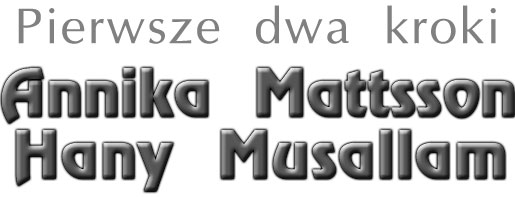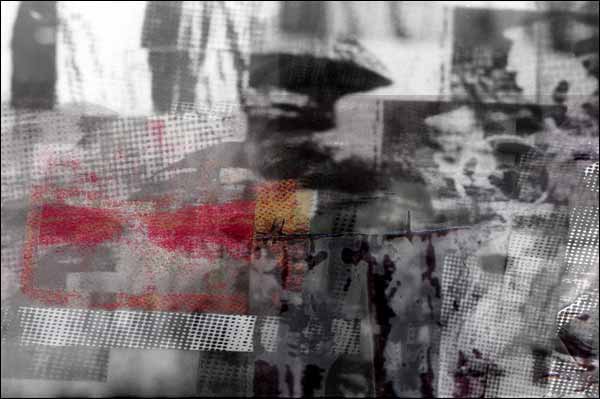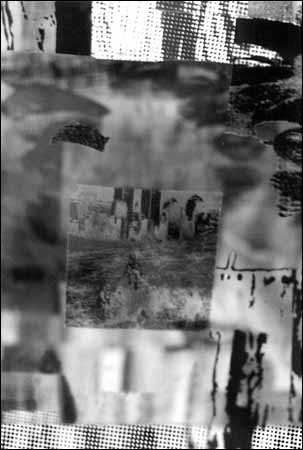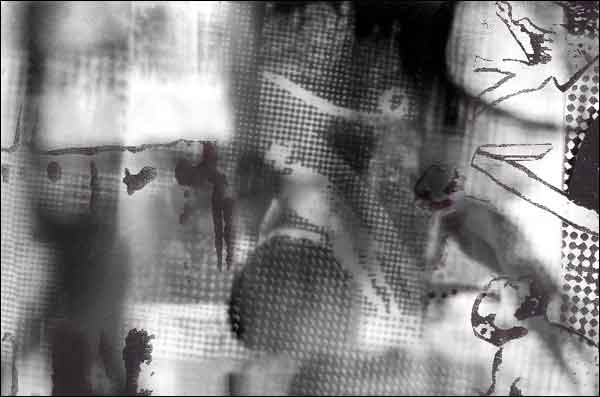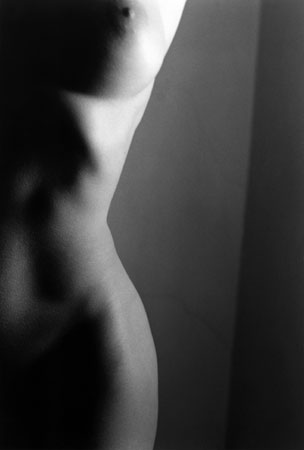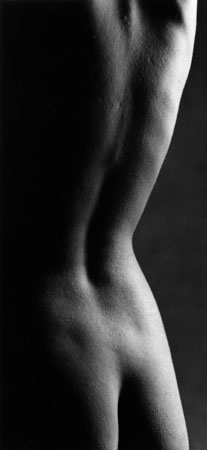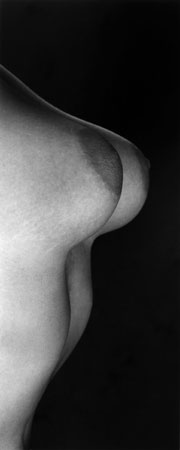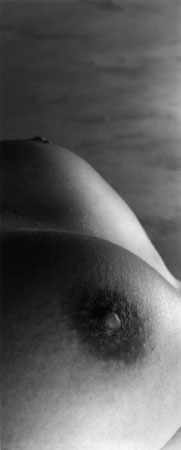The first two steps
10 - 31 III 2000
Annika Mattsson - instalacja: Ikony
Annika Mattsson - detal instalacji
Annika Mattsson - detal instalacji
Annika Mattsson - detal instalacji
Pierwsze dwa kroki "To moja pierwsza duża wystawa w FF, którą mam wspólnie z moim przyjacielem Hanym Musallam, opowiada o moich asocjacjach i myślach wokół mojej prywatnej historii, przeżyć i pamięci" - tymi słowami Anniki Mattsson z korespondencji do Krzysztofa Cichosza rozpoczynam mój tekst do wystawy dwojga młodych artystów, moich byłych studentów, absolwentów łódzkiej ASP im. Wł. Strzemińskiego.
Historia, która doprowadziła do tej wystawy wydaje się dość osobliwa. Annika Mattsson - Szwedka oraz Palestyńczyk - Hany Musallam, spędzili w Polsce kawałek swojego życia, chyba dla nich bardzo istotny i ważny. Przybyli z dwóch różnych stron świata, z odmiennym bagażem kulturowym. Ich losy związała uczelnia, a w szczególności fotografia, którą studiowali w prowadzonej przeze mnie Pracowni Fotografii Użytkowej. Poprzez prezentowane utwory możemy poznać diametralnie różne osobowości artystyczne Anniki i Hanego. Zważywszy na odmienność kręgów kulturowych, z których się wywodzą - różnice te są czymś naturalnym. Istnieje jednak element spajający - jest nim ogromna pasja do fotografii.
Podziwiam ich inwencję i samodzielność. Sami sobie "wychodzili" tę wystawę w Galerii FF, to znaczy: przedstawili dojrzały, jak na start, zestaw prac i ciekawą aranżację. I jeszcze jedno - chcą obydwoje związać choćby w części swoje dalsze losy z Polską. Może dlatego, że czas młodzieńczych doświadczeń, marzeń i ambitnych planów, czas, który zapamiętuje się najsilniej przypadł właśnie w trakcie pobytu w Polsce. To tutaj kształtowała się osobowość artystyczna każdego z nich, to tutaj rodził się "początek przyszłości", kierunek dalszego dojrzałego życia.
Annika Mattsson jest artystką wykraczającą poza klasyczne techniki. Oprócz fotografii studiowała malarstwo - pracownia dyplomująca u prof. Ryszarda Hungera. Jej prace - również i te szkolne - były z pogranicza różnych dyscyplin artystycznych, trochę jak collage lub instalacja z użyciem fotografii i innych obiektów. Znając Annikę, jej temperament, nie mogę sobie wyobrazić, by była w stanie nałożyć sobie ograniczenia np. w postaci jednej techniki czy jednego środka wyrazu. Jej prace zawierają przede wszystkim atmosferę osobistych przeżyć i wspomnień. Są podobne do kolorowej mozaiki losów ludzkich, splotów zdarzeń, zbiorowiska osobistych przedmiotów. Są jak mimowolnie wysypane rzeczy z szuflady zapomnianego mebla, pełne niby bezładnie porozrzucanych, nieostrych i zatartych zdjęć. Wszystko sprawia wrażenie pozornego chaosu, ale to nie jest działanie przypadkowe. Celem jest uruchomienie u widza skojarzeń z jego własnym bagażem doświadczeń. Prace Anniki zawierają nieuchwytną atmosferę ulotnych zdarzeń, często odczytywanych lub wyłapywanych podświadomością. Jej prace wymagają bardzo skupionego i wrażliwego odbiorcy, odpornego na mody i trendy współczesnej sztuki. W swoich pracach potrafi wydobyć specyficzne cechy medium fotografii, jej bliskie związki z przemijalnością i ulot-nością, nieostrością głębi i zjawiskowością. Z czasów studiów Anniki pozostał mi w pamięci obraz osoby wrażliwej, pochłoniętej poważnymi problemami Wielkiej Sztuki, potrafiącej również pozornie błahym, codziennym rozmowom o foto-grafii nadać inne, ciekawsze zabarwienie i oryginalny punkt odniesienia.
Inspiracje w pracach Hanego Musallam wypływają z innego źródła. Duży wpływ na treść i formę jego fotografii miała jego specjalizacja dyplomowa w zakresie projektowania ubioru w pracowni prof. Barbary Hanuszkiewicz. Tematyka fotografii Hanego związana jest głównie z aktem i ciałem człowieka. Hany świetnie czuje bryłę i przestrzeń. Na jego fotografiach dostrzegamy nie tylko sam akt, ale także konstrukcję i przestrzenną formę budowy człowieka. Hany lubi w fotografii konkret, z jego prac emanuje prawie fizyczna obecność rejestrowanych w studio ludzi. Lubi duże formaty powiększeń. W jego fotografiach czuje się dynamiczne napięcia i siłę emanującą z ponadnaturalnej wielkości cielesnych brył. Silny związek z rzeźbą, z którą ściśle łączy się przecież konstrukcja ubioru, jest bliski metodzie fotografowania Hanego. Za pomocą specyficznej cechy fotografii, jaką jest redukowanie, czy tzw. "ciasny kadr", w tym wypadku wręcz ściskanie ramami kadru nieograniczonej przestrzennie rzeczywistości - autor tworzy nowe "egzystencje cielesne", nowe kształty i formy. Ekspresja formy i precyzyjna kompozycja są podstawowymi wartościami fotografii Hanego. Oglądając jego prace odczuwa się wręcz analogie ze strukturami przestrzennymi map pejzaży, w tym wypadku "pejzaży ciała". W jego aktach indywidualne cechy portretowanych postaci odnajdujemy w strukturze i konstrukcji, w szorstkości bądź gładkości skóry, pulchności załamków ciała i w krągłościach lub bryłowatościach napiętych mięśni.
Annika i Hany - ich pierwsze kroki w przyszłość rozpoczęte w Galerii FF - stały się faktem.
prof. Grzegorz Przyborek
Łódź, 18 lutego 2000 r.
Hany Musallam - oryginał 146/99 cm
Hany Musallam - oryginał 259/97 cm
Hany Musallam - oryginał 246/97 cm
Hany Musallam - oryginał 247/98 cm
The first two steps "The exhibition at the FF Gallery, in which I'm taking part together with my friend Hany Mussalam, is my first big exhibition. It tells about my associations and reflections on my private history, experiences and memory" - I chose these words Annika Mattsson wrote in a letter to Krzysztof Cichosz as the beginning of my text on the exhibition of two young artists - and my former students - graduates of the Władysław Strzemiński Academy of Fine Arts in Łódź.
The story of how this exhibition came about seems somewhat strange. Annika Mattsson, of Swedish nationality, and Hany Mussalam, a Palestinian, spent a considerable part of their lives in Poland which probably turned out for them to be extremely important and significant. They came to Poland from two different parts of the world and different cultural backgrounds. Their fates became entwined by the school they entered, and particularly by photography which they studied in the Workshop of Applied Photography under my supervision.
Through the works shown at the exhibition we can get to know the radically different artistic personalities of Annika and Hany. Bearing in mind their different cultural backgrounds such differences seem to be something quite natural. There is, however, a com-mon element shared by the two artists - great passion for photography.
I admire their invention and independence. They owe the organization of the exhibition at the FF Gallery only to themselves, which means that, considering that they are at the start of their career, they presented a mature set of works and suggested their interesting arrangement. One more thing - they both want to tie their fates in the future with Poland, at least partly. Perhaps because the time of their youthful experiences, dreams and ambitious plans, the time one always remembers most vividly, happened to be the time they spent in Poland. It was here that their artistic personalities were shaped, here the "beginning of the future" was born and the direction of their further, adult lives first marked.
Annika Mattsson is an artist who reaches beyond traditional techniques. Along photography she studied also painting - at the workshop supervised by professor Ryszard Hunger. Her works, including those she created at school, came from the borderlines of various artistic disciplines, resembling collages or installations employing photography and other different objects. Knowing Annika and her temperament I cannot imagine that she could would be able to limit herself for example to the use of only one technique or means of expression. Her works contain most of all the atmosphere of her personal experiences and memories. They resemble a colourful mosaic of human destinies, knots of events, sets of personal belongings. They are like objects involuntarily thrown out of a drawer of a forgotten piece of furniture, full of seemingly vague photographs, out of focus and thrown around in disorder. It all makes the impression of apparent chaos, but the effect cannot be attributed to chance. Annika's works aim at stimulating the viewer's associations with his/her own load of experiences. They contain the elusive atmosphere of volatile events, often recognized or grasped by our unconscious. Her works demand a very concentrated and sensitive public, resistant to the fashions and fads of contemporary art. She can reveal specific features of the photographic medium, its close ties with transitoriness and evasiveness, its blurred depth and phenomenality. From the time of Annika's studies I remember her as a sensitive person, engaged in serious problems of Great Art, who could give an interesting tint and original point of reference to seemingly more banal, everyday conversations on photography.
Inspiration in the works of Hany Mussala comes from a different source. A significant influence on the form and content of his photographs was his major specialization in fashion design in the workshop supervised by professor Barbara Hanuszkiewicz. The subject of Hany's photographs is basically connected with nudes and the human body in general. Hany has got an excellent "feel" of space and mass. What we notice in his photographs is not jus the nude alone, but also the construction and the spatial form of the structure of the human body. Hany is fond of concrete images in his photography, and his works seem to emanate a nearly physical presence of the people photographed in the studio. He likes large format blow-ups. In his photographs one can feel dynamic tensions as well as the force, generated by the supernaturally large body masses. Hany's photographic method is closely connected to sculpture, which is in turn related to fashion design. Employing a specific feature of photography, namely the reduction of a frame, i. e. the so-called "narrow frame", which in his case means an almost physical squeezing of the spatially unlimited reality within a photo-graphic frame - that is how he creates new "bodily existences", new shapes and forms. The expression of form and precise composition are the basic values of Hany's photographs. Watching them one discovers almost an analogy with the spatial structure of landscape maps, being in this instance "bodyscapes". In his nudes we can find the individual features of the people he portrays in their structure and construction, in the roughness or smoothness of their skin, the plumpness of the folds of their bodies and in the roundness or angularity of their strained muscles.
Annika and Hany - their first steps into the future, taken in the FF Gallery - have now become a fact.professor Grzegorz Przyborek
Łódź, 18th February, 2000
Copyright ©2000 Galeria FF ŁDK, Annika Mattsson, Hany Musallam.
